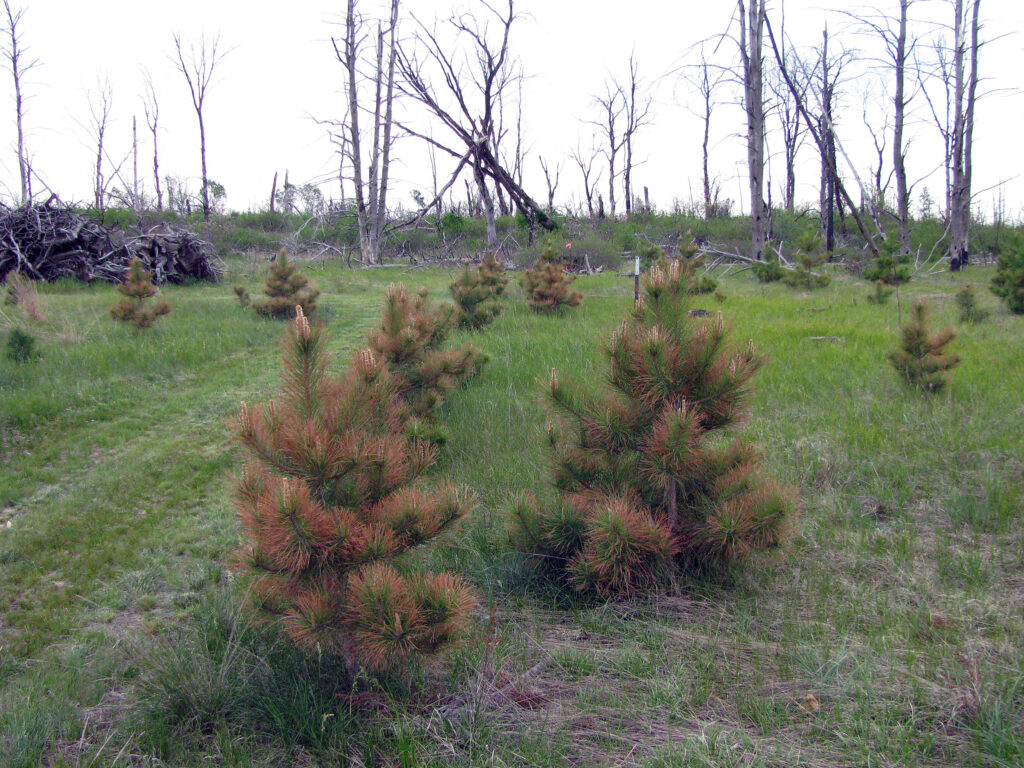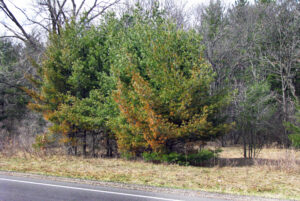
Minor to moderate damage to white pine needles caused by winter desiccation. Photo: Wisconsin DNR
By Michael Hillstrom, DNR Forest Health Specialist, Fitchburg
michael.hillstrom@wisconsin.gov
Winter damage is one of the most commonly reported tree issues in early spring. The damage may be minor, such as off-color needles that are quickly replaced, but could be as severe as partial- or whole-tree mortality.
Winter desiccation occurs when conifers begin photosynthesizing on warm, windy days in late winter or early spring. Conifers may dry out in these conditions if they use their stored water and cannot replace it because the ground is still frozen.
Affected trees typically have partially or fully dead needles on the parts of the tree exposed to sun and wind. Trees can recover from minor or moderate needle damage but if the damage is severe, top kill or tree mortality may occur.
Salt damage symptoms can show similarities to winter desiccation, occurring along roads and other surfaces where salt is used. Salt may damage needles if sprayed onto trees by passing vehicles and can damage roots if salt drains off surfaces into the soil near trees.

Minor needle damage to white pine needles along a highway from salt spray. Photo: Wisconsin DNR
Salt damage can be minor, allowing affected trees to recover rapidly. But it can be severe, causing bud damage, twig dieback and root damage. Some plants are more sensitive to salt than others, so avoid planting sensitive plants along roads or other surfaces where salt is used.
Sunscald and frost cracks, which cause vertical cracks on stems, can also impact trees in winter. Damage occurs when warm, sunny winter days are followed by freezing temperatures at night. Trees are often able to recover from the damage, but fungi can colonize the wounds and cause rot issues.
Frost damage is another common occurrence in spring. Buds and expanding leaves may be damaged by frost, but trees often flush out new leaves within a month. Roots can also be damaged by frost if there is no snow cover to insulate them.
Snow and ice also damage trees during winter. For example, extremely heavy, wet snow damaged thousands of acres of trees in northwest Wisconsin and northeast Minnesota in December 2022. Trees will recover from minor branch breakage, but severe impacts can occur.
Trees typically recover from many of the above issues, but repeated or severe events may kill trees or stress them enough that insects and fungi can invade and cause mortality. Remove severely impacted trees to prevent the buildup of insects and diseases. Corrective pruning should be completed before bud break.
For additional information, visit the University of Minnesota webpage on protecting trees and shrubs in winter.
